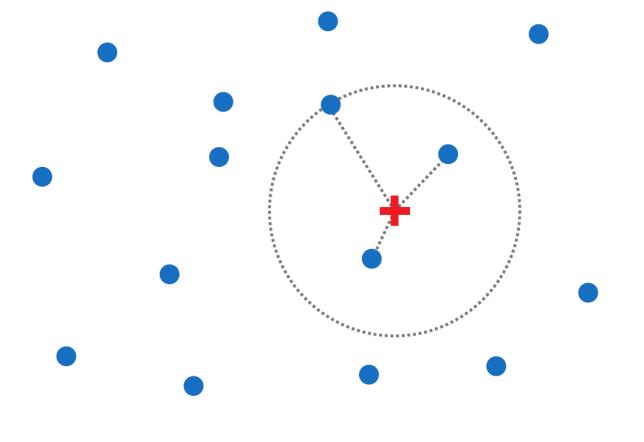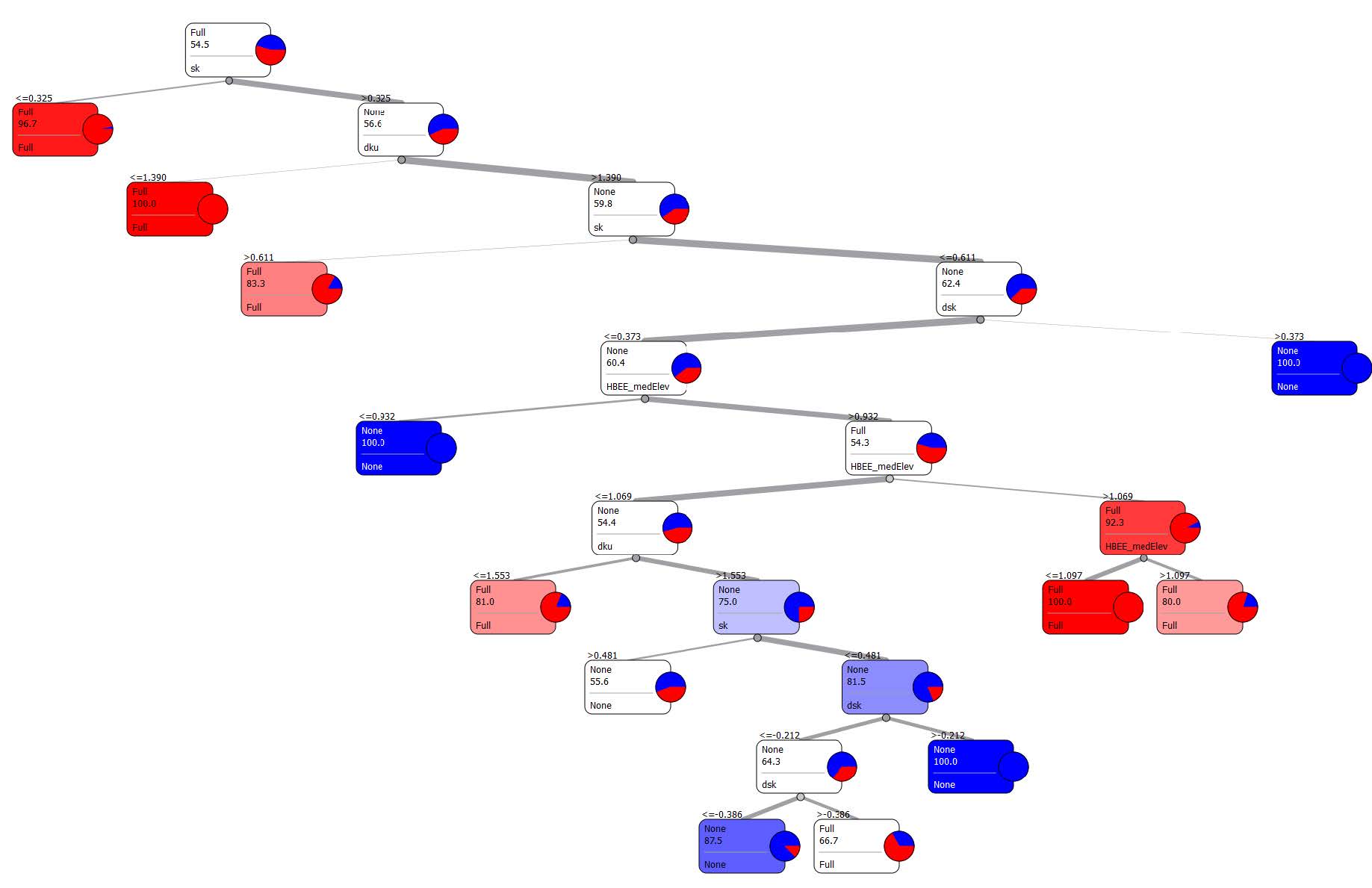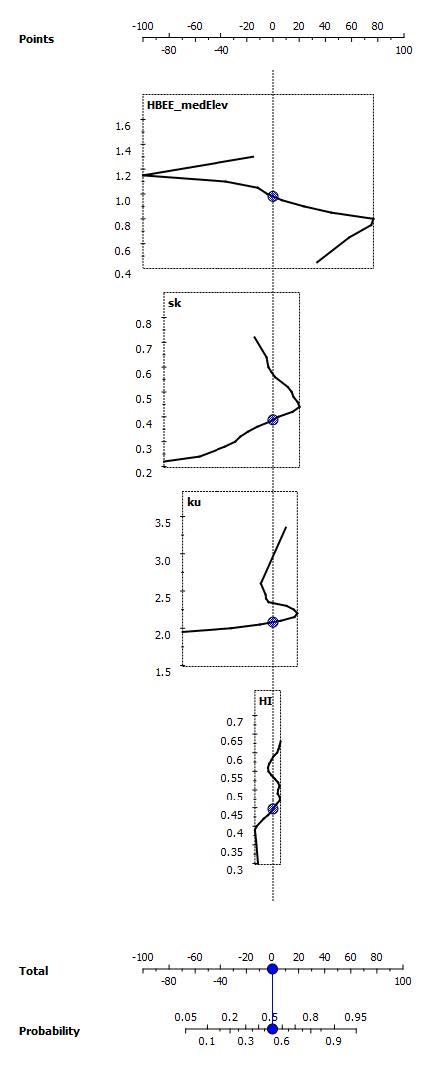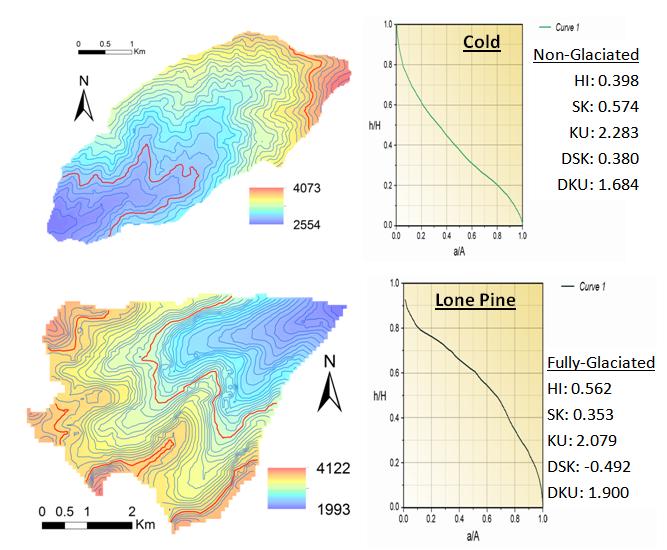The extent of glaciation in alpine valleys often gives clues to past climates, plate movement, mountain landforms, bedrock geology and more. However, without field investigation, the degree to which a valley was affected by a glacier has been difficult to assess. We developed a model that uses quantitative parameters derived from digital elevations model (DEM) data to predict whether a glacier was likely present in an alpine valley. The model's inputs are mainly derived from the basin hypsometry, and a new parameter termed the Hypothetical Basin Equilibrium Elevation (HBEE), which is based on the equilibrium elevation altitude (ELA) of a glacier. We used data mining techniques that comb through large data sets to find patterns for classification and prediction as the basis for the model. Four classifiers were utilized, and each was tested with two different training set/test data ratios of nearly 150 basins that were previously delineated as fully- or non-glaciated. The classifiers had a predictive accuracy of up to 90% with none falling below 72%. Two of the classifiers, classification tree and naïve-Bayes, have graphical outputs that visually describe the classification process, predictive results, and in the naïve-Bayes case, the relative effectiveness towards the model of each attribute. In all scenarios, the HBEE was found to be an accurate predictor for the model. The model can be applied to any area where glaciation may have occurred, but is particularly useful in areas where the valley is inaccessible for detailed field investigation.
1.
Introduction
Modeling and forecasting stock market volatility is an important research topic in financial markets. Because stock market volatility plays key roles in market timing decisions, portfolio selection, asset pricing and risk management.
Since the seminal study in Schwert [1], extensive research has been carried out on the economic sources of financial volatility (e.g., Diebold and Yilmaz [2], Christiansen et al. [3], Paye [4], Engle et al. [5], Conrad and Loch [6], and Nonejad [7], Wang et al. [8,9], Zhang et al. [10]). However, Paye [4] shows that although some variables in theory (such as national debt spreads and default gains) will affect the volatility of stocks, it is difficult to find a single variable that can predict stock volatility. In particular, adding any macro variable to the baseline autoregressive model does not significantly improve the performance of out-of-sample prediction. The failure of the predictive power of each basic variable in stock volatility prompted scholars to find new predictors. Feng et al. [11] showed the oil volatility risk premium does indeed exhibit statistical and economic significance from the in-sample and out-of-sample prediction capabilities in G7 countries. Crude oil volatility is found to be an efficient predictive of stock volatility in the short-term in Wang et al. [12] from an out-of-sample perspective. Dai et al. [13] find that the implied volatility of stock market can provide efficient predictability for the stock return volatility in 5 developed economies.
Inspired by Feng et al. [11], Wang et al. [12] and Dai et al. [13], we find that three new variables, gold volatility, exchange rate volatility, US dollar index(DXY), can strongly predict stock volatility of Hang Seng Index (HSI) which is significant in different sampling periods. Gold as a leading candidate since it receives widespread attention in finance. Baur and Lucey [14] show that gold is a hedge against stocks on average and a safe haven in extreme stock market conditions. Another study on this specific topic was by [15,16], who examine the role of gold in the global financial system by testing the hypothesis that gold represents a safe haven against stocks of major emerging and developed countries. In addition, as oil price changes affect numerous economic variables, such as production costs, inflation, interest rates, investment, economic growth, terms of trade, and consumer and investor confidence. These economic variables affect both the exchange rate market and the stock market [17,18,19,20]. Because in international markets, oil prices are expressed in US dollars; thus, the dollar exchange rate may affect the price perceived by consumers and producers of oil and oil-related products. Pal et al. [21] apply the multifractal cross-correlation analysis method to investigate the cross-correlation behavior and fractal nature between two nonstationary time series, and put the hypothesis of gold as a safe haven in extreme currencies. Dynamic linkages and cross-correlation among oil price, gold price, exchange rate, and stock market are investigated by Jain and Biswal [22], Li et al. [23].
Although various research has studied information spillover between gold, exchange rate and stock volatility. Most papers use multiple GARCH models to study from the perspective of in-sample for different markets (e.g., Mishra et al. [24], Choi et al. [25], Walid et al. [26], Grobys [27], Oberholzer and Boetticher [28], Mensi et al. [29], Dai et al. [30], Choudry et al. [31], Maghyereh et al. [32]). However, it is generally known a predictive model enjoys good in-sample performance does not mean which can obtain excellent out-of-sample performance. In addition, the above mentioned papers focus on single spillover between gold and stock volatility, or exchange rate and stock volatility. In this paper, we will contribute to the literatures by focusing on the predictive ability of gold and exchange rate to stock volatility forecasting from both in-sample and out-of-sample perspective.
Our survey complements the study of volatility modelling and prediction by providing new basic determinants of stock market volatility. Our findings also are helpful to understand the economic causes of changes in stock market volatility. Hong Kong stock market is an important stock market that ranked among the top 10 in the world by market capitalization. Meanwhile, Hong Kong stock market is the closest financial center in China, which has a significant interaction with the economy, politics, geography and other aspects of the mainland. It is clear that investigating the Hong Kong stock market can help us understand the impact of volatility on stock return in emerging markets. In addition, gold has attracted investors who have been paying attention to financial assets that provide diversified returns to currencies for decades. It can act as a safe haven against extreme currencies. The distinguishing feature of gold as a hedging or hedging asset is the dependence structure between gold and the exchange rate, especially the average and extreme market dependence. Therefore, investigating the predictive role of gold and exchange rates in the volatility of the stock market is of great benefit to regulation for international financial market.
We use the daily price data from January 1989 to December 2018 for the Hang Seng Index (HSI) and prices of London Spot Gold, New York Futures Gold and HKD/CNY, HKD/EUR, and the US dollar index (DXY). When we make an empirical analysis for full sample, a more significant in-sample prediction ability is found for gold and exchange rate. Using the extended AR(P) model with each predictor, we obtain the forecasts for out-of-sample stock returns volatility of HSI. Following the relative literatures, we use the out-of-sample ${R^2}$ ($R_{OoS}^2$) to evaluate the statistical performance of individual forecasts. We also employ the CW statistic proposed by Clark and West (2007) to inspect the statistical significance of stock return volatility predictability. Out-of-sample experiment results including different sample periods, business cycles, incremental framework show gold and exchange rate have good and robust out-of-sample performance.
The remaining of this paper is as follows: we show the research data and descriptive statistics in Section 2. Section 3 presents the econometric methodology including in-sample regression model, out-of-sample forecasting approach and evaluation method. The empirical analysis about in-sample predictive ability, out-of-sample prediction performance is reported in Sections 4 and 5, respectively. Section 6 investigates robustness analysis. The conclusion is given in the last section.
2.
Data and statistical description
We collect Hang Seng Index (HSI), London Spot Gold, New York Futures Gold from Wind Database (https://www.wind.com.cn/). The HKD/CNY, HKD/EUR, and the US dollar index (DXY) are downloaded from Hong Kong exchange rate data on the website of the Bank for International Settlements (BIS). In addition, we also collect the prices of Brent crude oil and West Texas Intermediate (WTI) crude oil from the Energy Information Administration.(www.eia.gov) which are studied in Wang et al [12]. The sample period of the data is from January 1989 to December 2018. Basic statistical descriptions of the main regression variables are listed in Table 1.
Consistent with literatures (e.g., Schwert [1], Paye [4], Taylor [33], and Dai and Zhu [34]), we use the arithmetic square root of the sum of daily return squares as the agent of the monthly stock, oil, gold and exchange rate returns volatility. For a specific month t, the realized volatility (RV) can be computed as:
where ${r_{t, j}}$ is the t-th daily return in the j-th month, and $M$ is the number of business days per month. According to Andersen and Bollerslev [35], Andersen et al. [36,37], the realized volatility in (1) is less noisy and based on ex-post variance. Daily price data is used to build actual monthly volatility.
3.
Methodology
3.1. Forecasting models
Although the benchmark of historical average is popular. Following Paye [4], Conrad and Loch [6], Nonejad [7], and Wang et al. [9], for stock volatility forecasting, a standard benchmark is the following autoregressive model (AR):
where ${V_t} = \log (R{V_t})$, the error term ${\varepsilon _{t + 1}}$ is assumed to follow an independent and identically normal distribution.
In order to study the predictability of gold, oil, and exchange rate volatility, we extend the AR(P) model by using the logarithm of gold, oil, and exchange rate volatility as additional predictors:
where ${V_{t, xi}}{\rm{ = }}\log (R{V_{t, xi}})$ represents the logarithm of oil, gold, and exchange rate volatility at the t month, and the parameter β reflects the impact of oil, gold, and exchange rate volatility on future stock volatility, and ${\varepsilon _{i, t + 1}}$ denotes an error term assumed to follow an independent and identically normal distribution.
3.2. Out-of-sample forecast and evaluation
Following relative literatures (e.g., [38,39,40,41,42,43,44,45,46,47,48,49]), we employ the out-of-sample R-square ($R_{os}^2$) to evaluate forecasting performance. It is calculated as the percentage reduction in the mean squared predictive error ($MSPE$) of the prediction model ($MSP{E_{\bmod el}}$) relative to that of the historical average benchmark ($MSP{E_{HA}}$), that is
where $MSP{E_{\bmod el}} = \frac{1}{{T - M}}\sum\nolimits_{t = M + 1}^T {{{({{\rm{V}}_t} - {{\widehat {\rm{V}}}_t})}^2}} $ and $MSP{E_{bench}} = \frac{1}{{T - M}}\sum\nolimits_{t = M + 1}^T {{{({{\rm{V}}_t} - {{\overline {\rm{V}} }_t})}^2}} $. Different from in-sample ${R^2}$, the value of $R_{OoS}^2$ can be equal to negative. Intuitively, a positive $R_{OoS}^2$ indicates that the forecasts by tested model have lower MSPE than the benchmark model (2), implying the greater accuracy of stock return volatility predictability.
In addition, we further assess the significance of predictability by applying the Clark and West [50] statistic to test the null hypothesis that ${MSP{E_{HA}}}$ is smaller than or equal to ${MSP{E_{\bmod el}}}$ against the alternative hypothesis that ${MSP{E_{HA}}}$ is larger than ${MSP{E_{\bmod el}}}$. The Clark and West [50] statistic is computed by first defining
then we obtain the statistic by regressing $\left\{ {{f_t}} \right\}_{m + 1}^T$ on a constant. The statistics can be proved to be equivalent to the t-statistic of the constant, then we can use the upper-tail test for standard normal distribution to obtain the p-value.
4.
In-sample results
Following Inoue and Kilian [51], in-sample predictability is necessary for out-of-sample predictability. It is unreasonable to find out the out-of-sample predictability with in-sample predictability absent. In order to eliminate this bias, the one-sided test proposed by Inoue and Kilian [51] is also carried out to test the null hypothesis of $\beta {\rm{ = }}0$ $ \mathrm{ } $ against alternative hypothesis $\beta \ne 0$.
Table 2 reports full sample regression results of stock realized volatility based on econometric model (3) where the coefficient of predictor, the Newey-West heteroskedasticity t-statistics (i.e. NW-t-statistics), and in-sample ${R^2}$ statistics are shown. The estimation results for different lag order of the realized volatility of stock market return in model (3) are shown in Panels A, B, C, and D of Table 2.
Being of our interest, the coefficient estimate of $\beta $ is significantly negative at 10% level, regardless of whether oil, gold and exchange rate is included in the predictive model, indicating the in-sample predictability from oil, gold and exchange rate to stock volatility. What we can see is that all the NW-t-statistics are all greater than 1.40, which show the predictive ability of oil, gold and exchange rate is significant at 10% level. In addition, Campbell and Thompson [38] argue that a monthly $ {R}^{2} $ statistics near 0.5% can represent an economically significant predictability. All in-sample $ {R}^{2} $ statistics of gold and exchange rate are greater than this threshold, indicating the realized volatilities of gold and rate display powerful predictive abilities.
Overall, oil, gold and exchange rate exhibit significant predictability for the realized volatility of HSI. However, compared with oil, gold and exchange rate have stronger predictive ability, except for HKD/CNY. Among the seven predictors, the largest predictive ability is the US dollar index (DXY). Meanwhile, we can see that different lag orders of the realized volatility of stock market return in model (3) have some impact on volatility prediction where the lag order 6 is the best.
5.
Out-of-sample results
In financial practice, it’s of interest for market participants to learn the out-of-sample prediction performance as they pay more attention to how well the forecasting model will do in the future. Hence, we investigate whether adding oil, gold and rate volatility to the benchmark model (2) can significantly improve the forecasting accuracy. For stock volatility forecasting, it is obviously that different lag orders will have impact on the prediction ability. When we test the out-of-sample of seven predictors, we find that the lag order 6 also displays better out-of-sample performance which is consistent with in-sample results. Meanwhile, we can find that different lag orders have little effect on out-of-sample forecasting for stock return volatility for seven predictors. Therefore, we only report the out-of-sample performance for the lag order 6.
Table 3 reports out-of-sample forecasting results based on recursive estimation windows over a variety of sample periods. We give the out-of-sample $ {R}^{2} $ statistics as well as the P-values of CW test. All the out-of-sample $ {R}^{2} $ statistics exceed 0.6. The largest $ {R}_{OS}^{2} $ is 4.0415 of the US dollar index for the out-of-sample period of 2014-2018 and the smallest is 0.6122 of Hong Kong dollar to RMB for the out-of-sample period of 19944-2018. In short, the descending sort of forecasting ability is: DXY, HKD/EUR, New York gold, London gold, WTI Oil, Brent Oil, HKD/CNY. At the same time, the value of $R_{oos}^2$ gradually increases over time. That is to say, the out-of-sample predictability of the realized volatility of oil, gold, and exchange rate is stronger as time goes on.
6.
Robustness tests
6.1. Business cycles
The predictability of stock return volatility is dependent of business cycles (e.g. Neely et al. [39], Zhang et al. [52,53], and Choudhry et al. [54]). In view of this, it is worth for us to investigate whether the predictability of the stock market is different during the period of business expansion and recession. Specifically, we compute $R_{O{\rm{O}}S, c}^2$ statistics individually for expansion and recession where $R_{O{\rm{O}}S, c}^2$ is defined as follow:
where $ {I}_{c} $ is an indicator which takes the value of one when the economy in the month t is an NBER dated expansion (recession) and zero otherwise. In this subsection, we only report the $R_{O{\rm{O}}S, c}^2$ statistics for the out-of-sample period of 2004:01-2018:12.
Table 4 reports $R_{O{\rm{O}}S, c}^2$ statistics for the forecasting of realized volatility during economic expansion and recession periods, respectively. The out-of-sample $R_{O{\rm{O}}S, c}^2$ statistics of economic recession are greater than expansion period. All out-of-sample $R_{O{\rm{O}}S, c}^2$ statistics during the recession period exceed 1.4%, while all out-of-sample $R_{O{\rm{O}}S, c}^2$ statistics during the expansion period are less than 0.7%, which indicate the explanatory power of independent variables mainly derives from the economic recession. Meanwhile, the realized volatility of DXY still demonstrates the best predictive ability.
Overall, the predictability of stock realized volatility based on oil, gold, and exchange rate is stronger during economic recessions than that during economic expansions. The higher the $R_{O{\rm{O}}S}^2$ statistics for economic recessions all exceed 1.4% for the full-sample benchmark while for economic recessions all below 0.7%. From this we can see that the explanatory power of oil, gold, and exchange rate mainly comes from its predictive power at economic recession periods. In recessions, agammaegate risk is significantly higher and, consequently, investors care more about agammaegate shocks. In expansions, agammaegate risk is significantly lower and, consequently, investors care more about idiosyncratic shocks. This framework implies that the predictive information of economic fundamentals is linked to the observed state of the business cycle.
6.2. Predictability in an incremental framework
In addition to the traditional test, Chen et al [55] argue that it is also meaningful to capture predictive ability in incremental model:
where $ {∆\mathrm{V}}_{\mathrm{t}-1} $ represents the innovation in stock real volatility. Unlike the benchmark bivariate model, this incremental model focuses on the predictability of incremental framework.
Table 5 shows the in-sample and out-of-sample results of stock market realized volatility using realized volatilities of oil, gold and exchange rate in the incremental model (7). As can be seen from panel A, all the coefficients of realized volatilities of oil, gold and exchange rate are positive and exceed 0.10. Especially, the coefficients of DXY reaches 1.17. According to the P-value and NW-t-value statistics, we find that the confidence level of all independent variables is much higher than 10% level, which means that almost every independent variable has strong explanation. The out-of-sample results are reported in percentage at the bottom of Table 5. It can be seen that all of $R_{oos}^2$ statistics exceed 1, and the $R_{oos}^2$ values of HKD/EUR and DXY are even more than 3%, which again indicates the predictability of the independent variable. The $R_{OoS}^2$ statistics exceed 1%, which indicates that the forecasts by tested model have lower MSPE than the benchmark model (2), implying the greater accuracy of stock return volatility predictability than the benchmark model (2).
7.
Conclusion
In this paper, we aim to show that gold and exchange rate volatility are predictive of stock volatility from both in-sample and out-of-sample perspectives in Hong kong stock market. We use daily data spanning January 1989 to December 2018 for the Hang Seng Index (HSI) and prices of, London Spot Gold, New York Futures Gold and HKD/CNY, HKD/EUR, and the US dollar index (DXY). The squared daily returns in each month are summed to construct monthly realized volatility. Our in-sample results show there exists very significant predictability from gold and exchange rate volatility to stock volatility in full sample period. We use recursive estimation window to generate one-step-ahead out-of-sample forecasts of stock volatility. Out-of-sample experiment results including different sample periods, business cycles, incremental framework show gold and exchange rate have good out-of-sample prediction performance.
Following Paye [4], Conrad and Loch [6], Nonejad [7], and Wang et al. [9], the AR model the error term is assumed to be independent identical normal distribution. Because the noise could be white noise or any other forms in practical application, it may limit the ability of the model. A more robust approach with detailed merit will be investigated in the future work.
Acknowledgments
This paper is supported by the National Natural Science Foundation of China granted [71771030,11301041], the Scientific Research Fund of Hunan Provincial Education Department [grant number 19A145].
Conflict of interest
All authors declare no conflicts of interest in this paper.









 DownLoad:
DownLoad:








